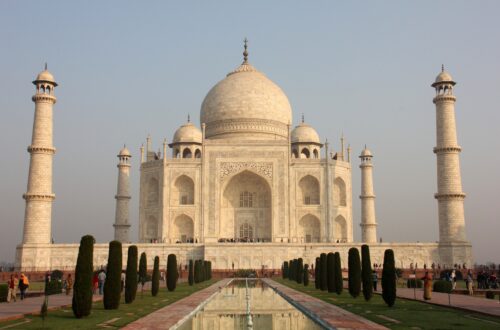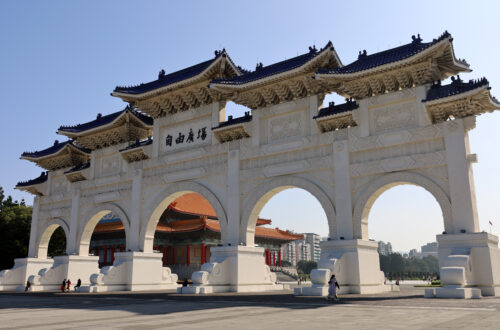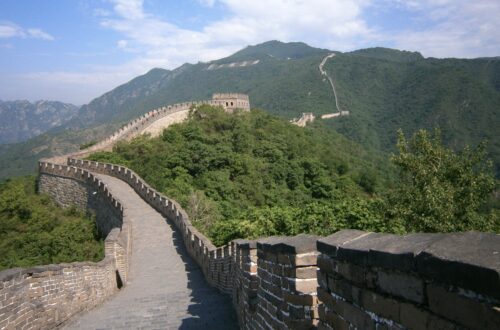
Dubai, United Arab Emirates
After a flight of more than six hours, over the Sinai, Saudi Arabia and the Persian Gulf, I land at Dubai International Airport at around 12:30 AM local time. I visit the emirate – one of the seven United Arab Emirates (UAE) – on my way to neighboring Oman. During my stopover I have two days to explore Dubai. Passport control is smooth and I only have hand luggage with me, so I can get through quickly. Unfortunately, no subways run to the city at night. Looking for alternative transport, I run into a Belgian mother and daughter who are staying in a hotel near mine, so we decide to share a taxi. At 2 AM I go to bed.
Dubai originated in the eighteenth century as a small fishing village where the Khor Dubai, the Dubai Creek, flows into the Persian Gulf. For a long time it remained a modest port town, mainly focused on regional trade. However, the discovery of oil in the 1960s changed everything. Dubai became more prosperous and began to grow at a rapid pace. More and more parts of the surrounding desert were cultivated. In the 1980s, Dubai was already a medium-sized city, but the really explosive growth was yet to come. The petrodollars poured in, new buildings became bigger and more luxurious and the city attracted more and more super rich. Dubai even got a ski palace – mind you: in the middle of the desert – and striking projects such as Palm Jumeirah (manufactured luxury islands off the coast in the shape of a palm tree) attracted the emirate worldwide attention. In 2023, Dubai is a metropolis with four million inhabitants.
After a short night I get up early for my first day in Dubai. The weather is lovely: sunny and about 25 degrees. At the metro station I buy a day pass (Nol card) for unlimited use of the metro for a day. The metro in Dubai is well-arranged: there are only two lines. The metro is quite indispensable to explore Dubai, because the city on the coast of the Persian Gulf is huge. The modern high-rise buildings with shiny skyscrapers that you know from the photos are concentrated in Downtown and the Dubai Marina. Other than that, the city mainly consists of low-rise buildings. That means that the distances in the city are large. The Sheikh Zayed Road runs straight through the city from north to south, connecting all parts of the city. Sheikh Zayed Road is a wide ten-lane road with grade-separated intersections and pedestrian bridges.

My first visit is the Burj Khalifa. With a height of 828 meters, the Burj Khalifa is the tallest building in the world. Its construction began in 2004 and lasted only six years. It is an impressively tall building, tapering from its broad base and gleaming in the sunlight. It towers far above all other (also tall) buildings in Downtown. To visit the Burj Khalifa you must buy a ticket for a time slot online in advance. With dizzying speed, the elevator whizzes in no time to the 124th floor, where the observation deck is. From 452 meters you look out over the city. Even Downtown’s other skyscrapers look like miniature buildings from this height. From this height you can also see how low-rise and vast Dubai is. And that outside the city there is nothing but desert.
At the foot of the Burj Khalifa is the Dubai Mall, with 1,200 stores the largest shopping center in the world. I walk along the Dubai Mall Promenade, which runs along the man-made Burj Khalifa Lake (where a fountain show is given in the evening). There are plenty of places to eat and drink along the promenade and on the other side of the water is the Souk Al Bahar, a traditionally styled, sand-colored building, with more restaurants. On the west side, next to Burj Park, is the Dubai Opera, which opened in 2016 and is shaped like the prow of a ship. What is striking is that there is still a lot of construction going on everywhere; Dubai is apparently far from finished.

A short metro ride takes me to Dubai’s newest architectural masterpiece: the Museum of the Future, which opened in 2022. The museum is housed in an elliptical building with an outer facade of stainless steel, decorated with Arabic calligraphy. I think it is a very beautiful and special building. What is striking when you walk down the street – except for the fact that extremely expensive cars regularly pass by – is that you come across people of all nationalities and see just as many different clothing styles: from modern Western to traditional Arabic. Men in suits and men in dishdasha (or kandora), women in tight jeans and women in niqab.
After lunch (tip: restaurant Zaroob for delicious Lebanese food) I take the metro to the south of the city. From the Mall of the Emirates stop it is still quite a walk to the Souk Madinat Jumeirah. This is a modern version of the traditional Arabic souk, with a wooden roof and numerous shops. You can buy everything from traditional clothing to colorful oil lamps and from beautifully decorated water pipes to Persian carpets. The modern souk is at the heart of a complex of hotels and restaurants. From here you can also see the Burj Al Arab, the hotel built in the 1990s in the shape of a white sail, which is still the icon of Dubai. You can’t enter the Burj Dubai unless you’re eating or sleeping there, and neither can you visit many of the beaches along this part of the coast, which belong to the luxury hotels and resorts.

In the afternoon I take the metro to the part of the city known as the Dubai Marina. This large marina is located around an artificial canal surrounded by modern high-rise buildings. The most striking (and bizarre) building is undoubtedly the Cayan Tower, a square tower that rotates ninety degrees. I walk down the Marine Walk Promenade along the water and also take a look at what is known as the ‘Walk at JBR’. This turns out to be a rather touristy boulevard with restaurants, cafes and shops.
On my second day in Dubai I go to the place where the city was born: the area around the Khor Dubai. I walk to the historic district of Bur Dubai on the water of the creek. Here is the Al Fahidi District (formerly known as the Bastakia Quarter), one of the oldest districts in Dubai. The district has been completely renovated and the sand-colored buildings and narrow streets give an impression of what old Dubai must have looked like. It is a world of difference from the modern high-rise a few kilometers away. At the heart of the Al Fahidi District is the white Diwan Mosque and close by is Al Fahidi Fort, probably the oldest surviving building in Dubai. It is a sand-colored limestone fortress, with three towers and a heavy teak entrance gate. The local sheikh lived here until 1896, now the Dubai Museum is located here. Next to the fort is the Dubai Grand Mosque with its tall minaret (the tallest in Dubai).

Behind the mosque are the narrow streets of the Bur Dubai Souk, lined with shops selling textiles, herbs, spices, and souvenirs. Through the narrow streets I reach the water of the Khor Dubai. Traditional wooden boats called abras take passengers across to the Deira district in about a minute for a fee of one dirham. Deira is known for its souks, a jumble of bazars, each specialized in something: herbs and spices, gold, perfumes, household items, et cetera. It is very busy, you are constantly approached by sellers and there are many tourists, especially in the Gold Souk.
Dhows, traditional cargo ships with a blue-painted superstructure, line Deira’s quay, and are still used to transport all kinds of goods from other countries in the region to Dubai. The wharf is filled with everything from televisions to scooters.
Back on the other side of the water I have lunch at the Arabian Tea House. In the afternoon it is time to go to the airport for my flight to Oman. Although I’m not into the luxury resorts, nightlife or extravagant wealth that Dubai is known for, I was curious about this metropolis in the desert. It is undeniably a fascinating city, with different faces; cutting-edge and traditional. Even if you don’t go for the luxury and nightlife, Dubai is worth a visit, especially if you are in the area or, like me, on your way to neighboring Oman.




